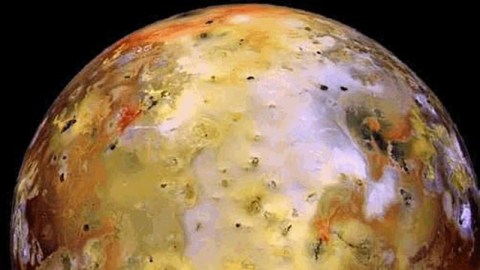The gooey interior of Io (and why it likely isn’t a “magma ocean”)

One of the more exciting frontiers in geology is that of planetary volcanology – that is, how do volcanoes work on other planets. We know at least a few in our solar system have volcanism in one form or another – silicate magma, sulfur magma, liquid water – and both active and extinct volcanoes. So, it should be no surprise that any new findings on the volcanic activity on other planets would be newsworthy … but sometimes that news just doesn’t match the actual science involved.
Take Io, for example. This moon of Jupiter, one of the Galilean moons of the planet, is, by far, the most volcanically active body in the solar system (including Earth). Remember, volcanism is just the manifestation of a planetary body trying to lose heat and reach thermal equilibrium with space around it. Unlike Earth, who’s internal heat is derived from dominantly radioactive decay of U, Th and potassium (with some added heat of formation and very minor tidal energy from the Moon and Sun), Io’s heat is almost exclusively from the tidal forces (pdf) the moon feels from orbiting Jupiter. The moon orbits a mere ~ 421,000 km from the center of Jupiter (whose radius itself is ~71,500 km). In contrast, our moon has roughly the same orbit, but around a much smaller planet. This means that Io feels much more gravitation pushing and tugging as it whizzes around Jupiter in a mere 1.77 Earth days. All this tidal energy from these quick orbits around Jupiter generate a lot of heat inside Io through friction, and thus a lot of volcanism as that heat tries to find ways to escape.
We didn’t know about the active volcanism on Io (see below) until the Voyager spacecraft visited the Jovian system, but when they did, the probes captured images of 300 km volcanic plumes coming from giant caldera systems – it looked like the entire surface was covered with lava. Later visits from the Galileo mission confirmed this very active volcanism on Io, with surface lava temperatures of 1250-1450C, meanly likely ultramafic compositions (komaiites – very low silica content, below 45 weight % and rare on Earth). However, the internal structure of the moon was still a mystery.

That is where a new study in Science by Khurana et al. (well, Science Express until it comes out in print) comes in. They tried to address the internal structure of Io by looking at how Io disrupts Jupiter’s magnetic field and by doing so, they found evidence that there is a “global conducting layer” within Io. For those of you who follow this sort of imaging in the Earth, that screams out “molten rock” (or at least fluids). Khurana et al. (2011) go onto say that this conducting layer has to be at least 50 km thick (Io’s radius is ~1,821 km) with at least 20% melt in that layer. Now, how did they did this number? Well, it involves a lot of math, but the long and short is they modeled Io as having similar structure to Earth – an Fe-Ni core of ~900 km radius and 30-50 km of silicate crust – they tried to find the best model for the state of the mantle of Io based on its electromagnetic properties (measured during the Galileo missions).
So, what does this all mean. Well, according to the article and the many popular press pieces that followed the UCLA press release for this Science piece, it means that Io has a so-called “magma ocean” feeding all the volcanoes (it doesn’t help that the active itself is titled “Evidence of a Global Magma Ocean in Io’s Interior” – talk about a title for getting the media’s attention.) Sadly, that is well wide of the mark when it comes to the real findings of this study might be. First off, the words “magma ocean” suggest to one a vast sea of completely molten rock (see below) and just by reading that key findings in the study, that is not the case. They suggest “≥20%” rock melt fraction – that is, in any chunk of rock, 20% is molten. That might seem like a lot, but there are terrestrial studies in rheology that suggest that a rock will behave as a solid at upwards of 40% melt fraction, so a Ioan mantle with 20% melt will still be “solid”. Secondly, implying that all of Io’s volcanoes are fed by the “magma ocean” is misleading as well – it would be like saying that all of the Earth’s volcanoes are fed by the mantle. It is technically true, but is a gross generalization. Instead, Io is likely to behave like Earth where pockets of melt in the mantle feed specific volcanoes, but they may or may not be all interconnected to feed “all the volcanoes”, which is what a “magma ocean” concept implies to me. However, unlike Earth, a larger portion of that mantle is molten at a given time.

What can we take away from this study? Well, I think the key message is that Io, compared to Earth, has a very gooey mantle. Part of the Earth’s mantle, the asthenosphere, does behave like a plastic – it can flow and move although it is like >90% solid rock. On Io, it appears that the same layer of mantle is much more plastic, so the convection in Io’s mantle is likely very high, feeding specific volcanic centers, in Io’s desperate attempt to lose all the tidal heat generated inside the planet. All this melt in the mantle also means that likely most of the erupting lavas on Io have to be basalt or komatiites, as high percent melting of the mantle would produce these compositions. The long and short is that Io has got a lot of melt in its interior that can effectively feed the volcanoes on the moon (albeit not likely from all the same source/vat of magma).
What we don’t have is a vast “magma ocean” seething just under the surface on Io. Admittedly, the Science study was written by geophysicists, not petrologists/volcanologists, which can sometimes lead to these grand statements about the state of the interior of planets without much basic on real rocks. However, as appealing as a magma ocean might seem on a world that is as close to a true Hades in the solar system as we can get, it likely is much less “sexy” than that.





